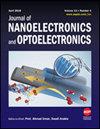Design and Performance Analysis of Photovoltaic Power Generation Light Emitting Diode Device
IF 0.6
4区 工程技术
Q4 ENGINEERING, ELECTRICAL & ELECTRONIC
引用次数: 0
Abstract
This research focuses on an independent photovoltaic power generation system with supercapacitor energy storage as the study subject. The model is simplified, and the photovoltaic power generation light emitting diode (LED) device is designed based on the given parameters. This system selects a Boost-type step-up converter for the supercapacitor charging circuit, capable of achieving Maximum Power Point Tracking (MPPT). The supercapacitor discharge circuit employs an LM2596 series regulator to power the rated load LED (12 V, 1 W), providing good linear regulation capability. In designing other hardware components of the device, the characteristics of a photoresistor are utilized to implement an automatic load switch circuit. An efficient single-chip integrated circuit LM2575 series is used as a regulator to convert the voltage across the supercapacitor terminals to +15 V and +5 V. Considering the need to collect the output voltage of the photovoltaic cell array and the voltage across the supercapacitor terminals, a resistor divider method is used to sample these two voltages. The sampling circuit includes a resistor divider circuit and a linear optocoupler isolation circuit. An HNC-25LTS series Hall current sensor is used for current sampling to measure AC, DC, and pulse signals under electrical isolation conditions. The supercapacitor, solar photovoltaic panel, control unit, and the main circuit for supercapacitor charging and discharging have been assembled in the experiment. Connecting the charging and discharging circuit with the photovoltaic panel and LED, the system provides power to the LED during the night. Under varying light intensity and temperature conditions, the photovoltaic output voltage waveform, PWM waveform, and Boost circuit output voltage waveform remain stable when reaching the MPPT point. The output power with added MPPT control at different times is compared. The results indicate that the designed system has effectively achieved the functionality of MPPT for solar energy.光伏发电发光二极管装置的设计与性能分析
本研究以超级电容器储能的独立光伏发电系统为研究对象。简化了模型,并根据给定参数设计了光伏发电发光二极管(LED)装置。该系统为超级电容器充电电路选择了升压型升压转换器,能够实现最大功率点跟踪(MPPT)。超级电容器放电电路采用 LM2596 系列稳压器为额定负载 LED(12 V,1 W)供电,具有良好的线性调节能力。在设计该设备的其他硬件组件时,利用了光敏电阻的特性来实现自动负载开关电路。考虑到需要收集光伏电池阵列的输出电压和超级电容器两端电压,因此采用了电阻分压器方法对这两个电压进行采样。采样电路包括一个电阻分压器电路和一个线性光耦隔离电路。HNC-25LTS 系列霍尔电流传感器用于电流采样,在电气隔离条件下测量交流、直流和脉冲信号。超级电容器、太阳能光伏板、控制单元和超级电容器充放电主电路已在实验中组装完毕。将充放电电路与光伏板和 LED 连接起来,系统在夜间为 LED 供电。在不同的光照强度和温度条件下,光伏输出电压波形、PWM 波形和 Boost 电路输出电压波形在达到 MPPT 点时保持稳定。比较了添加 MPPT 控制后不同时间的输出功率。结果表明,所设计的系统有效地实现了太阳能 MPPT 的功能。
本文章由计算机程序翻译,如有差异,请以英文原文为准。
求助全文
约1分钟内获得全文
求助全文
来源期刊

Journal of Nanoelectronics and Optoelectronics
工程技术-工程:电子与电气
自引率
16.70%
发文量
48
审稿时长
12.5 months
 求助内容:
求助内容: 应助结果提醒方式:
应助结果提醒方式:


